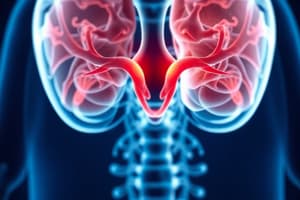Podcast
Questions and Answers
Which condition results from overproduction of Growth Hormone during childhood?
Which condition results from overproduction of Growth Hormone during childhood?
- Gigantism (correct)
- SIADH
- Diabetes insipidus
- Cushing’s disease
Which of these is a posterior pituitary syndrome?
Which of these is a posterior pituitary syndrome?
- Diabetes insipidus (correct)
- Gigantism
- Acromegaly
- Cushing's disease
What does SIADH stand for?
What does SIADH stand for?
- Syndrome of impaired kidney function
- Syndrome of inadequate hormone release
- Syndrome of inappropriate secretion of ADH (correct)
- Syndrome of improper growth hormone
What is a common underlying factor for both Gigantism and Acromegaly?
What is a common underlying factor for both Gigantism and Acromegaly?
Which of the following conditions is associated with the posterior pituitary gland?
Which of the following conditions is associated with the posterior pituitary gland?
Which condition is characterized by stunted growth in children?
Which condition is characterized by stunted growth in children?
What hormone is associated with SIADH?
What hormone is associated with SIADH?
Which of the following is NOT a pituitary disorder mentioned?
Which of the following is NOT a pituitary disorder mentioned?
What part of the pituitary is associated with diabetes insipidus?
What part of the pituitary is associated with diabetes insipidus?
Which condition is specifically associated with hypersecretion of a particular hormone?
Which condition is specifically associated with hypersecretion of a particular hormone?
Which condition is characterized by atrophy of the extremities in adults?
Which condition is characterized by atrophy of the extremities in adults?
What type of secretion is associated with Diabetes insipidus?
What type of secretion is associated with Diabetes insipidus?
Which condition involves the excessive release of ADH?
Which condition involves the excessive release of ADH?
What is a characteristic feature of Simmond's disease?
What is a characteristic feature of Simmond's disease?
Which of the following conditions is NOT associated with the posterior pituitary?
Which of the following conditions is NOT associated with the posterior pituitary?
What is the term for excessive thirst, often experienced even after drinking?
What is the term for excessive thirst, often experienced even after drinking?
Which term describes the excretion of large volumes of urine?
Which term describes the excretion of large volumes of urine?
How many primary types of diabetes insipidus are identified?
How many primary types of diabetes insipidus are identified?
What is one of the two main categories of diabetes insipidus presented here?
What is one of the two main categories of diabetes insipidus presented here?
Based on the provided text, what is the other main category of diabetes insipidus, besides central?
Based on the provided text, what is the other main category of diabetes insipidus, besides central?
Which condition is characterized by the hyposecretion of ADH?
Which condition is characterized by the hyposecretion of ADH?
What is a primary effect of diabetes insipidus on the body?
What is a primary effect of diabetes insipidus on the body?
Which of the following directly leads to water imbalance in the body?
Which of the following directly leads to water imbalance in the body?
Which of the following conditions is not directly related to ADH levels?
Which of the following conditions is not directly related to ADH levels?
What is the main characteristic of the syndrome related to ADH hyposecretion?
What is the main characteristic of the syndrome related to ADH hyposecretion?
What is the primary consequence of the distal convoluted tubule (DCT) and collecting duct becoming impermeable to water?
What is the primary consequence of the distal convoluted tubule (DCT) and collecting duct becoming impermeable to water?
What is the most direct consequence of decreased water reabsorption from renal tubules and collecting ducts?
What is the most direct consequence of decreased water reabsorption from renal tubules and collecting ducts?
What does 'polydipsia' refer to within the context of the content?
What does 'polydipsia' refer to within the context of the content?
What is the direct effect of ADH absence on the kidney's tubules?
What is the direct effect of ADH absence on the kidney's tubules?
If the distal convoluted tubule and collecting duct are permeable to water, what effect would this have on the body?
If the distal convoluted tubule and collecting duct are permeable to water, what effect would this have on the body?
Flashcards
Gigantism
Gigantism
A condition caused by excessive production of the growth hormone (GH) during childhood, leading to abnormal and excessive growth.
Syndrome of Inappropriate ADH Secretion (SIADH)
Syndrome of Inappropriate ADH Secretion (SIADH)
A syndrome characterized by excessive antidiuretic hormone (ADH) secretion, leading to water retention and hyponatremia (low sodium levels in the blood).
Diabetes Insipidus
Diabetes Insipidus
A condition resulting from insufficient production or release of antidiuretic hormone (ADH) from the posterior pituitary gland, leading to excessive water loss through urine.
Posterior Pituitary
Posterior Pituitary
Signup and view all the flashcards
Cushing's Disease
Cushing's Disease
Signup and view all the flashcards
Syndrome of Inappropriate Antidiuretic Hormone Secretion (SIADH)
Syndrome of Inappropriate Antidiuretic Hormone Secretion (SIADH)
Signup and view all the flashcards
Dwarfism
Dwarfism
Signup and view all the flashcards
Simmond's Disease
Simmond's Disease
Signup and view all the flashcards
Antidiuretic Hormone (ADH)
Antidiuretic Hormone (ADH)
Signup and view all the flashcards
Acromicria
Acromicria
Signup and view all the flashcards
What causes Diabetes Insipidus?
What causes Diabetes Insipidus?
Signup and view all the flashcards
Central Diabetes Insipidus
Central Diabetes Insipidus
Signup and view all the flashcards
Nephrogenic Diabetes Insipidus
Nephrogenic Diabetes Insipidus
Signup and view all the flashcards
Polydipsia
Polydipsia
Signup and view all the flashcards
Polyuria
Polyuria
Signup and view all the flashcards
ADH's role in water reabsorption
ADH's role in water reabsorption
Signup and view all the flashcards
Distal Convoluted Tubule (DCT)
Distal Convoluted Tubule (DCT)
Signup and view all the flashcards
Collecting Duct
Collecting Duct
Signup and view all the flashcards
Study Notes
Pituitary Disorders
- Pituitary disorders result from hyperactivity or hypoactivity of the pituitary gland
- The pituitary gland is located in the sella turcica (sphenoid bone)
- The anterior pituitary produces hormones that affect growth, metabolism, and reproduction
- The posterior pituitary stores and releases hormones produced by the hypothalamus
Anterior Pituitary Disorders
- Hyperactivity:
- Gigantism (childhood): Excessive growth hormone leads to extreme height
- Acromegaly (adulthood): Excessive growth hormone leading to enlargement of hands, feet, and facial features
- Cushing's disease: Excessive ACTH production leading to cortisol overproduction, causing obesity, muscle weakness, and other symptoms
- Hypoactivity:
- Dwarfism (childhood): Deficiency of growth hormone leads to stunted growth
- Acromicria: Atrophy of extremities due to a deficiency of growth hormone
- Simmond's disease: Chronic deficiency of pituitary function, leading to emaciation and death if untreated
Posterior Pituitary Disorders
- Syndrome of Inappropriate Antidiuretic Hormone (SIADH): Excess ADH secretion causing water retention and dilution of blood sodium levels, leading to symptoms like loss of appetite, weight loss, nausea, vomiting, headaches, muscle weakness, and fatigue. The condition can be fatal if not treated. This can result from tumors of the brain or lungs.
- Diabetes Insipidus: Hyposecretion of ADH causing excessive urination due to inability of the kidneys to retain water. This can be caused by either a problem with the pituitary gland, or by problems or inability of kidney tubules to respond to ADH.
Acromegaly
- A hormonal disorder affecting middle-aged adults
- Continuous excessive growth hormone production causes enlargement of bones (hands, feet, facial features like jaw protrusion)
- Characterized by thickened lips, protruding lower jaw, and large hands and feet
- Often accompanied by increased blood sugar (hyperglycemia) and diabetes.
Treatment for Pituitary Disorders
- Drug therapy (Bromocriptine)
- Radiation therapy
- Surgery (remove pituitary adenoma)
Cushing's Syndrome
- Characterized by obesity, a round face (moon face), and a "buffalo hump" on the upper back.
- Causes: tumors of the adrenal cortex or pituitary gland. Pituitary tumors are called "Cushing's disease."
- The symptoms arise from the increased cortisol levels from the adrenal glands.
Dwarfism
- Characterized by stunted growth, with normal body proportions except for a slightly larger head.
- Causes may include growth hormone deficiency, a tumor of chromophobe cells in the pituitary gland, or lack of hypothalamic growth hormone releasing hormone (GRH).
Acromicria
- Rare disease in adults characterized by atrophy and thinning of extremities of the body
- Causes may include growth hormone deficiency and a lack of growth hormone releasing hormone (GRH).
Diabetes Insipidus
- Characterized by excessive excretion of fluids (polyuria).
- This condition can result from a lack of antidiuretic hormone (ADH).
- Two types:
- Central: Degeneration of the hypothalamus nuclei (which produces ADH), or injury in the hypothalamo-hypophyseal tract, or posterior pituitary degeneration.
- Nephrogenic: Inability of renal tubules to respond to ADH
- Symptoms include polyuria, polydipsia( extreme thirst), and dehydration.
Diagnosis
- Fluid deprivation test
- Blood reports
- Urine reports
Studying That Suits You
Use AI to generate personalized quizzes and flashcards to suit your learning preferences.
Related Documents
Description
Test your knowledge on various pituitary disorders, including Gigantism, Acromegaly, and SIADH. This quiz covers the physiological functions and associated conditions of the pituitary gland, focusing on both hypersecretion and deficiency states. Perfect for students in endocrinology or health sciences!




